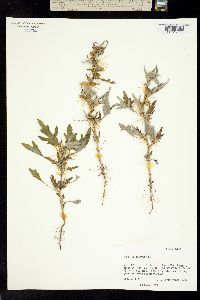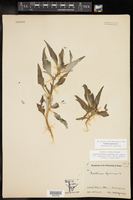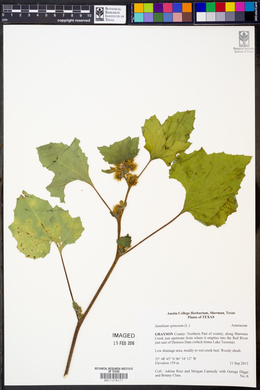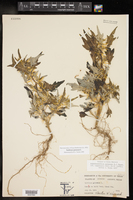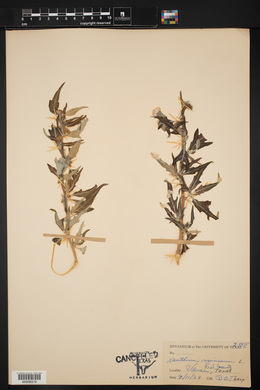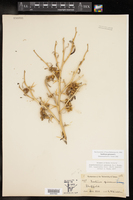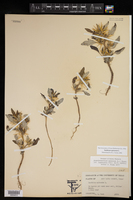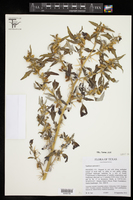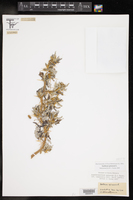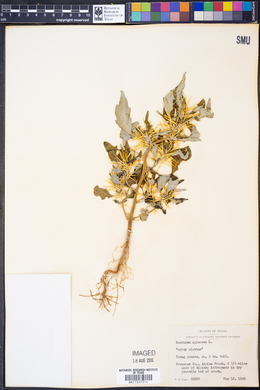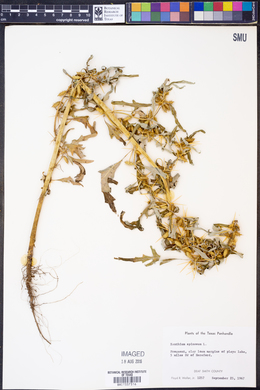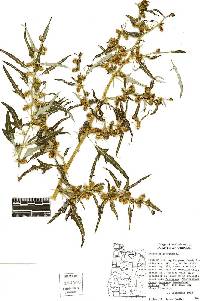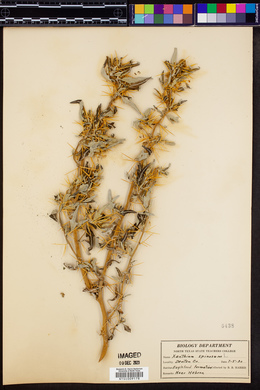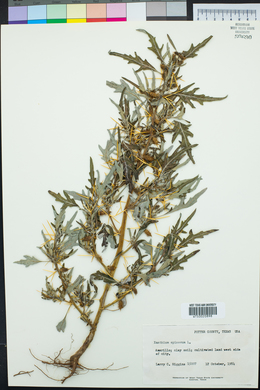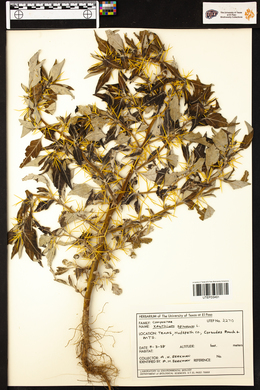Xanthium spinosum
|
|
|
|
Family: Asteraceae
spiny cocklebur, more...Spiny Cockleburr, Bathurst burr, cocklebur, spiny colklebur
[Acanthoxanthium spinosum (L.) Fourr., moreXanthium spinosum var. inerme Bel.] |
Plants 10-60(-120+) cm; nodal spines usually in pairs, simple or 2-3-partite, 15-30+ mm. Leaves: petioles 1-15(-25+) mm; blades ± ovate to lanceolate or lance-linear, 4-8(-12+) × 1-3(-5+) cm, often pinnately 3(-7+)-lobed, abaxial faces gray to white, densely strigose. Burs 10-12(-15+) mm. 2n = 36. Flowering Jul-Oct. Damp or seasonally wet, alkaline soils, waste places, margins of agriculture; 10-1000 m; N.B., Ont., Que., Sask.; Ala., Ariz., Calif., Colo., Conn., Del., Fla., Ga., Idaho, Ill., Ind., Iowa, Kans., Ky., Maine, Md., Mass., Mich., Miss., Mo., Mont., Nebr., Nev., N.H., N.J., N.Mex., N.Y., N.C., Ohio, Oreg., Pa., R.I., S.C., Tenn., Tex., Utah, Va., Wash., W.Va.; Mexico; Central America; South America; widely established in Old World. Some authors have contended that Xanthium spinosum originated in South America and is introduced and/or naturalized everywhere else that it is found.
USDA-GRIN, Baldwin 2013 in Jepson, FNA 2006, Heil et al 2013, MacDougall 1973 Duration: Annual Nativity: Non-Native Lifeform: Forb/Herb General: Exotic annual herbs, 10-60 cm tall; stems erect, branched, with 1 or 2 gold-colored spines at each node; spines simple or 3-branched, 1-3 cm long or longer. Leaves: Alternate along the stems, on short petioles usually less than 1 cm long; blades lanceolate to lance-linear, 4-8 cm long, 1-3 cm wide, usually with shallow pinnate lobes, the upper leaf surface shiny green and the lower surface densely white or gray strigose. Flowers: Flowering heads are inconspicuous and unisexual. Inflorescence a terminal or axial cluster of staminate flowering heads, with 1 or 2 pistillate heads near the apex. Staminate flowers have translucent corollas, pistillate flowers lack a corolla. Fruits: Burr is cylindric, 10-15 mm long, yellow to brown, with slender spines. Ecology: Found in disturbed, seasonally wet, often alkaline sites, especially grasslands, marshes and watercourses, from 3,000- 7,600 ft (914-2316 m); flowers July to October. Distribution: Origin is obscure, but it is often said to be native to South America. This is a fully cosmpolitan species, naturalized throughout the world including Europe, Asia, Africa, Australia, and North America. In North America it is reported from almost all of t Notes: There are only two species of Xanthium in our area. The native X. strumarium has broad, triangle-shaped leaves and lacks the distinctive golden nodal spines of X. spinosum. Solanum rostratum has spiny stems and fruits and lobed leaves, but it differs from X. spinosum because the spines are straw colored or green (not golden as in X spinosum). Also S. rostratum has showy yellow flowers, the leaves and petioles are prickly, and the bottom sides of the leaves are not silvery-pubescent. X. spinosum is fairly uncommon in the Southwest, being found mostly near Prescott and the Verde Valley in Arizona and in widely scattered locations in New Mexico and southeast Colorado. Ethnobotany: The Cherokee had several medicinal applications, including treatment of intestinal problems and snake bites. Etymology: Xanthos is Greek for yellow, referring to the yellow dye made from Xanthium strumarium, and spinosum refers to the nodal spines. Editor: AHazelton 2015, AHazelton 2017 Plants 3-12 dm, the stems strigose or puberulent; lvs lanceolate, entire or with a few coarse teeth or pinnate lobes, tapering to each end, short-petiolate, 2.5-6 נ0.5-2.5 cm, sparsely strigose or glabrate above, except for the usually more hairy main veins, densely silvery- sericeous beneath, bearing a tripartite yellow spine 1-2 cm in the axil; burs mostly solitary or few in the axils, cylindric, ca 1 cm, beakless or with a single short beak, finely puberulent and provided with slender, hooked prickles; 2n=36. Waste places; now a cosmopolitan weed in the warmer parts of the world, and occasionally found in our range. July-Oct. (Acanthoxanthium s.) Gleason, Henry A. & Cronquist, Arthur J. 1991. Manual of vascular plants of northeastern United States and adjacent Canada. lxxv + 910 pp. ©The New York Botanical Garden. All rights reserved. Used by permission. From Flora of Indiana (1940) by Charles C. Deam This species has been reported from Clark, Franklin, Jefferson, and Putnam Counties. Young, in 1875, said that it was spreading and not uncommon ten years before in Jefferson County, mostly along roadsides. I have traveled all of the principal roads of Jefferson County and have done considerable botanical work there and I have never seen it. This would indicate that for some reason it is not spreading. It may be that landowners have recognized the plant as a weed and eradicated it. I found it in a hogyard and along the roadside near Mauckport in Harrison County and in a hogyard and an adjacent pasture and roadside east of Cannelton in Perry County. …… Indiana Coefficient of Conservatism: C = null, non-native Wetland Indicator Status: FACU |










